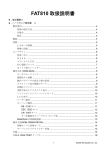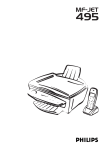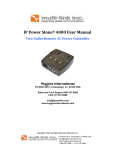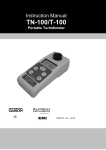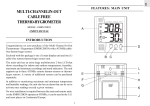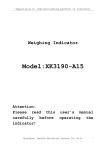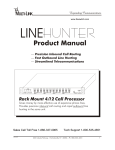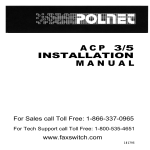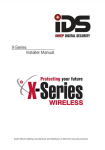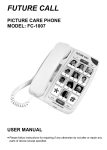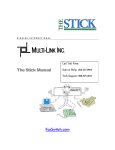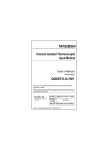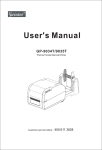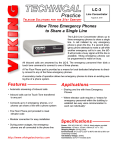Download FaxJack User Manual - Ultimate Distinctive Ring
Transcript
FaxJack - Distinctive Ring Auto Call Processor
Eliminate the Expense of Dedicated Phone Lines!
The FAXJACK allows any business, large
or small; to enjoy the convenience of
automated data transmission without the
perpetual monthly expense of a dedicated
phone line.
The FAXJACK is a versatile phone/data/fax
switch with the ability to automatically route
calls via fax CNG tone, central office
distinctive ring, or touch tones included in
the dial string by the calling party. In
addition, the FAXJACK offers full manual
transfer capabilities.
The FAXJACK stores and retransmits caller
ID information so that it is truly caller ID
compatible.
The FaxJack is the only single line distinctive ring automatic call routing
technology in the whole world that is:
•
•
•
•
•
•
Fully Caller-Id Compatible
Supports 1 to 3 distinctive ring numbers plus primary
Automatically detects and routes fax or modem calls on primary and
distinctive ring numbers
Provides tone detection and distinctive ring in the same application.
Supports up to 4 devices
Includes easy plug-in female RJ-11 jacks installation kit
Features
• Four ports allow any four analog devices to share a single line
• Routes calls via CNG tone, distinctive ringing, touch tones sent by calling device or
manually
• Provides realistic ring-back tones while re-ringing selected device
• Transfer from one port to another as often as may be required during the same call
• Caller ID information is stored and retransmitted during transfer
• Automatic “privacy” eliminates interruptions on both in and outbound calls
• Monitors for calling party control (CPC)
• All in and outbound calls are routed to the phone 1 port during a power failure
• Manual mode will not interfere with C.O. provided voice mail
• Ports are balanced to prevent noise on long runs
• Compatible with high-speed modems
• Surge protection on both power and phone line
• Internal Call Mode
Applications
Fax Machines
• Retail
• Governmental
• Commercial
• Home office
• Industrial
Modem Terminals
• Personal computers
• Vending machines
• Remote access applications
• Satellite Modems
• Fax/Modem
Phone Management
• TDD/ TTY Machines
• Separate Personal from Business Phones
• Multiple Answering Machines
Point-Of-Sale Terminals
• Fast food chains
• Retail stores
• Convenience stores
Specifications
Power: 120V AC/13.8V AC 1.25A, UL listed adapter provided
Dimensions: 133mm x 91mm x 44mm (5.25” x 3.6” x 1.75”)
Shipping Weight: 1.36 kg (3 lbs)
Environmental: 0°C to 32°C (32°F to 90°F) with 5% to 95% non-condensing humidity
CNG Detection: 1100 Hz burst
Maximum Data Speed: 56 Kbps
Minimum CPC Time: 320ms
Ring Output: 4 REN, capable of ringing (8) 0.5 REN phones
REN: 0.7A
Connections: (1) 10-position cage clamp terminal strip
Installation and Applications
A. Fax / Data / Phone Application
Note: The polarity of the connection to the CO Line In terminals shown to the right
should be (+) or Tip to terminal 1 and (-) or Ring to terminal 2. Observing this polarity
helps prevent clicks and dings of connected phones on hang up.
* Note: To increase surge protection, fasten a wire from the screw terminal to Earth
Ground (grounding rod, water pipe, etc.)
B. PABX / KSU Application
* Note: To increase surge protection, fasten a wire from the screw terminal to Earth
Ground (grounding rod, water pipe, etc.)
C. Installing a FAXJACK on a Residential Line
The FAXJACK is designed to be wired at the Demarcation Point (the point where the
phone line comes into the house), but in some cases this may not be possible or
convenient. This section shows a way of hooking up the FAXJ- 1000 to any existing
phone jack, provided the house is wired for at least two lines. A splitter/adapter is
required for each jack in the house (ie: Radio Shack part # 279-402).
Step 1.
The connection of the FAXJACK to the telephone line can be at any extension wall jack.
Unplug anything connected to the selected jack and plug a splitter/adapter into the jack.
Step 2.
Connect the CO LINE IN terminals of the FAXJACK to the Line 1 port of the
splitter/adapter. If the phone line is a DSL line, a DSL filter should be installed as shown
in the diagram below.
Step 3.
Connect the PHONE 1 terminals of the FAXJACK to the Line 2 port of the
splitter/adapter.
Step 4.
Unplug any phones at extension wall jacks located away from the FAXJACK and plug in
splitter/adapters. Reconnect the phones to the Line 2 side of the splitter/adapters.
Note: At any point “down line” from the FAXJACK where it is impractical to insert a
splitter/adapter (ie: a wall mount phone), this type of jack can be converted by:
1. Swapping the GREEN wire with the BLACK wire.
2. Swapping the RED wire with the YELLOW wire.
The phone can then be plugged into the converted jack.
* Note: To increase surge protection, fasten a wire from the screw terminal to Earth
Ground (grounding rod, water pipe, etc.)
Programming
A. DIP Switch Programming
B. Accessing the Programming Mode
C. Quick Programming Features
Operation
A. Automatic Answer Mode
Note: If using distinctive ring service from the telephone company and distinctive ring is
enabled (dip switch 2 set to ON), see Operation, section F and G.
If caller ID is enabled, the FAXJACK waits two seconds after the first CO (telephone
company) ring to receive and store the caller ID data and then answers the line. If caller
ID is disabled, it answers the line immediately after the first ring. The FAXJACK then
starts generating ringback tones to the caller every four seconds, while listening in the
interval between ringbacks for fax CNG tones or Touch Tones to route the call
(see Operation, section E for a description of how incoming touch tones can be used to
route calls).
If fax CNG tone or touch tones are detected, the FAXJACK starts ringing the
appropriate device, maintaining four seconds of off time between rings. If fax CNG tones
or touch tones are not detected after two ringbacks, the FAXJACK starts ringing the
Phone 1 port. The selected port is rung until the ring limit is met
(see Operation, section F).
Step 1. Incoming phone line rings. If caller ID is enabled, the FAXJACK delays for 2
seconds to capture and store the caller ID data.
Step 2. The FAXJACK answers the line. The FAXJACK is compatible with distinctive
ringing features offered by the telephone company. If you have the distinctive ring
feature, the FAXJACK will direct the call to the appropriate port based on the ring
cadence it detects (see Operation, section G).
Step 3. The FAXJACK listens for one of the following:
a. CNG tones (1100 hz tone burst) from an incoming automatic fax machine wishing to
be connected to the on premise fax machine.
b. Touch tones from an incoming caller wishing to be connected to a specified device
(i.e. "11111" for the Fax port, "22222" for the Modem port, "33333" for the Phone 1 port
and "44444" for the Phone 2 port).
c. Two touch tones from an incoming caller, a touch tone “#” and a second touch tone to
route the call (ie: #1 for the fax port, #2 for the modem port, #3 for the Phone 1 port or #4
for the Phone 2 port).
Step 4. The FAXJACK generates ring back tones to the incoming caller. In the below
example the caller hears one CO ring back plus three FAXJACK ring back tones (before
getting answered by the called device).
Step 5. The FAXJACK generates ringing (routes the incoming call) to the appropriate
port based on what was detected.
If none of the above signals were detected, the FAXJACK generates ringing (routes the
incoming call) to the Phone 1 port.
1. Automatic Answer Mode Incoming Call Sequence, Caller ID Enabled
Note: If fast call processing is enabled (see Programming section C), the second 4second listening time is eliminated, so that the FAXJACK rings the appropriate port after
the first 4-second listening time. Enabling fast call processing can make it more likely for
a fax call to be incorrectly routed to the Phone 1 port because CNG tone is not detected.
2. Automatic Answer Mode Incoming Call Sequence, Caller ID Disabled
B. Manual Answer Mode
Note: If using distinctive ring service from the telephone company and distinctive ring is
enabled (dip switch 2 set to ON), see Operation, section G.
In the manual answer mode, CO ringing passes directly through to the Phone 1 port. In
this mode, the FAXJACK waits for the call to be manually answered by the Phone 1 port
and then begins watching for fax CNG tones or touch tones to route the call. The Phone
1 port will continue to ring, subject to the Ring Limit (see Operation, section F). If the
call is answered by the Phone 1 port and a fax CNG tone is detected, the FAXJACK
provides a busy signal to Phone 1 and starts ringing the call to the FAX port. Phone 1
can also dial a touch tone transfer command to transfer the call to another port (see
Operation, section C). Following the transfer command, the FAXJACK provides a busy
signal to Phone 1 and starts ringing the call to the appropriate port.
C. Transfers
While the FAXJACK is a four-port unit, only one port can be connected to the phone line
at any given time. If, for example, the Phone 1 port is using the line and any of the other
ports tries to make a call, they are given an internally-generated busy signal. However,
the FAXJACK has the ability to transfer calls from one port to another.
Calls are transferred by dialing "#" + the number associated with the port you want to
transfer the call to. These two touch tones must be the first touch tones dialed by the
phone or device making the transfer in order to prevent accidental transfers during other
dialing sequences.
When a transfer command is detected, the transferring port is provided with a busy
signal and the FAXJACK starts ringing the port that the call is being transferred to. It
keeps track of the port that initiated the transfer so it can ring that port back if the called
port doesn't answer. Any FAXJACK port that is connected to the phone line can transfer
and there is no limit to the number of transfers on a given call.
Note: If a phone is wired on the CO LINE IN side of the FAXJACK and you want to stop
the FAXJACK from transferring, pick up the phone and dial #0. The FAXJACK will then
hang-up and you will have the call.
D. Touch Tone Routing
In the automatic answer mode, the FAXJACK looks for touch tones as one method of
routing the call to the correct device. These touch tones are dialed at the calling end,
most often by an automatic device like a modem. In this example, the REMOTE modem
dials the phone number of the FAXJACK, and then executes a series of pauses long
enough to allow the call to connect (the CO to produce one ring and the FAXJACK to
answer). After the FAXJACK answers, the modem dials a series of touch tone "2's” to
signal that the call should be sent to the modem port (the FAXJACK needs to detect at
least three touch tones to consider the string a valid command). When the FAXJACK
detects the series of “2’s” has ended, it then starts ringing the modem port. The chart
below shows how the touch tones and the FAXJACK ports are correlated:
It is also possible for the person calling the FAXJACK to route themselves to one of four
FAXJACK devices by dialing a “#” plus a touch tone 1-4 after the FAXJACK has
answered and while the FAXJACK is listening for CNG tone. “#1” steers the call to the
Fax port, “#2” to the Modem port, “#3” to the Phone 1 port and “#4” to the Phone 2 port.
E. Internal Calls
The internal call mode gives you the ability to create an “internal” call from one port of
the FAXJACK to any other port. This allows the phones behind the FAXJACK to
selectively call any phone on another port and communicate with that phone. When the
two ports are connected together, the telephone line is disconnected so you don’t hear
busy signals, re-order tones or intercept messages while talking. It works like this:
When you go off hook on one of the ports, you are connected to dial tone from the
telephone line. You then dial “#1” through “#4” to ring another port (“#1” = Fax, “#2” =
Modem, “#3” = Phone 1 and “#4” = Phone 2). When the “#1” through “#4” is dialed, the
telephone line is disconnected and you begin to hear a simulated ringback tone (single
frequency ringback tones – 500 Hz – 2 seconds on, 4 seconds off), as the FAXJACK
sends ringing to the appropriate port. Interrupted ringing is provided to the appropriate
port until the call is answered or the port that originated the call hangs up (no limit to the
number of rings). When the other port answers the call, the two ports are connected
together and can communicate. Once both phones hang up, the FAXJACK returns to
idle.
F. Ring Limit and Rollover
How incoming calls and Ring No Answer (RNA) situations are handled depends on the
operational mode selected (automatic or manual), the type of incoming call (voice, fax,
modem, etc.) and how the call was sent to the port (transferred call, CNG detected, etc.).
The following charts show how calls are handled in both operational modes and all
situations.
G. Distinctive Ringing
Distinctive ringing is an option provided by some telephone companies which permits
extremely accurate routing of calls. When using this feature, you are issued several
telephone numbers while having only one actual telephone line. When dialed, each
number will ring "distinctively". The FAXJACK can differentiate a distinctive ring cadence
from a standard ring cadence and route the call accordingly. "Normal" ring cadences are
routed to the Phone 1 port while distinctive ringing is routed to the other ports.
On "normal" rings, the FAXJACK will still monitor for fax CNG tones and touch tones,
before sending the call to the Phone 1 port.
* Note: If your "normal" ring is less than 1.8 seconds or a double ring, etc., you cannot
use this feature.
When the distinctive ring option is enabled in the FAXJACK, the automatic and manual
answer modes can still be selected. The manual answer mode (dip switch 3 set to on)
should only be used if telephone company voice mail is used on the same line as the
FAX-1000. In the manual answer mode, the FAXJACK does not answer the line
("normal" ring patterns), allowing compatibility with the telephone company provided
voice mail. If there is no telephone company voice mail on the line, the automatic answer
mode (dip switch 3 set to off) should be used.
1. Automatic Answer Mode
In the automatic answer mode, the FAXJACK monitors the ring pattern of the first CO
(telephone company) ring. If the FAXJACK detects a distinctive ring pattern, it answers
the call and starts ringing the device specified by the distinctive ring pattern. If the
FAXJACK detects a "normal" ring pattern, it answers the call then starts generating
ringback tones to the caller every four seconds, while listening in the interval between
ringbacks for fax CNG tones or touch tones to route the call (see Operation, section D
for a description of how incoming touch tones can be used to route calls). If fax CNG
tone or touch tones are detected, the FAXJACK starts ringing the appropriate device,
maintaining four seconds of off time between rings. If fax CNG tones or touch tones are
not detected after two ringbacks, the FAXJACK starts ringing the Phone 1 port. The
selected port is rung until the ring limit is met (see Operation, section E).
2. Manual Answer Mode
In the manual answer mode, CO (telephone company) ringing passes directly through to
the Phone 1 port. If the FAXJACK detects a distinctive ring pattern, it stops allowing the
CO ring to pass through to Phone 1 and starts ringing the device selected by the
distinctive ring pattern. If the ring cadence is a "normal" ring, the FAXJACK waits for the
call to be manually answered by the Phone 1 port and then begins watching for fax CNG
tones or touch tones to route the call. The Phone 1 port will continue to ring, subject to
the Ring Limit (see Operation, section E). If the call is answered by the Phone 1 port
and a fax CNG tone is detected, the FAXJACK provides a busy signal to Phone 1 and
starts ringing the call to the FAX port. Phone 1 can also dial a touch tone transfer
command to transfer the call to another port (see Operation, section C). Following the
transfer command, the FAXJACK provides a busy signal to Phone 1 and starts ringing
the call to the appropriate port.
The drawings below show the ring cadences and the FAXJACK ports they are
correlated to:
For installation assistance:
Product Support Line...715.386.8666 Fax Back Line...715.386.4345
Tech Support
IF YOU HAVE A PROBLEM, PLEASE CONTACT: TECHNICAL SUPPORT AT (715) 386-8666
Our Technical Support Department is available for assistance Monday 8am - 4pm and Tuesday
through Friday 8am - 5pm central time. So that we can give you better service, before you call
please:
1. Know the model number, the serial number and what software version you have
(see serial label).
2. Have your Technical Practice in front of you.
3. It is best if you are on site.
RETURNING PRODUCT FOR REPAIR
The following procedure is for equipment that needs repair:
1. Customer must contact Technical Support Department at 715-386-8666 to obtain a Return
Authorization (RA) number. The customer MUST have a complete description of the problem,
with all pertinent information regarding the defect, such as options set, conditions, symptoms,
methods to duplicate problem, frequency of failure, etc.
2. Packing: Return equipment in original box or in proper packing so that damage will not occur
while in transit. Static sensitive equipment such as a circuit board should be in an anti-static bag,
sandwiched between foam and individually boxed. All equipment should be wrapped to avoid
packing material lodging in or sticking to the equipment. Include ALL parts of the equipment.
C.O.D. or freight collect shipments cannot be accepted. Ship cartons prepaid to:
Viking Electronics, 1531 Industrial Street, Hudson, WI 54016
3. Return shipping address: Be sure to include your return shipping address inside the box. We
cannot ship to a PO Box.
4. RA number on carton: In large printing, write the R.A. number on the outside of each carton
being returned.
RETURNING PRODUCT FOR EXCHANGE
The following procedure is for equipment that has failed out-of-box
(within 10 days of purchase):
1. Customer must contact Technical Support at 715-386-8666 to determine possible causes for
the problem. The customer MUST be able to step through recommended tests for diagnosis.
2. If the Technical Support Product Specialist determines that the equipment is defective based
on the customer's input and troubleshooting, a Return Authorization (R.A.) number will be issued.
This number is valid for fourteen (14) calendar days from the date of issue.
3. After obtaining the R.A. number, return the approved equipment to your distributor, referencing
the R.A. number. Your distributor will then replace the product over the counter at no charge. The
distributor will then return the product to Manufacturer using the same R.A. number.
4. The distributor will NOT exchange this product without first obtaining the R.A. number from
you. If you haven't followed the steps listed in 1, 2 and 3, be aware that you will have to pay a
restocking charge.
LIMITED WARRANTY
The manufacturer warrants its products to be free from defects in the workmanship or materials,
under normal use and service, for a period of one year from the date of purchase from any
authorized distributor or 18 months from the date manufactured, which ever is greater. If at any
time during the warranty period, the product is deemed defective or malfunctions, return the
product to Viking Electronics, Inc., 1531 Industrial Street, Hudson, WI., 54016. Customer must
contact the Technical Support Department at 715-386-8666 to obtain a Return Authorization
(R.A.) number.
This warranty does not cover any damage to the product due to lightning, over voltage, under
voltage, accident, misuse, abuse, negligence or any damage caused by use of the product by the
purchaser or others.
NO OTHER WARRANTIES. MANUFACTURER MAKES NO WARRANTIES RELATING TO ITS
PRODUCTS OTHER THAN AS DESCRIBED ABOVE AND DISCLAIMS ANY EXPRESS OR
IMPLIED WARRANTIES OR MERCHANTABILITY OR FITNESS FOR ANY PARTICULAR
PURPOSE.
EXCLUSION OF CONSEQUENTIAL DAMAGES. MANUFACTURER SHALL NOT, UNDER ANY
CIRCUMSTANCES, BE LIABLE TO PURCHASER, OR ANY OTHER PARTY, FOR
CONSEQUENTIAL, INCIDENTAL, SPECIAL OR EXEMPLARY DAMAGES ARISING OUT OF
OR RELATED TO THE SALE OR USE OF THE PRODUCT SOLD HEREUNDER.
EXCLUSIVE REMEDY AND LIMITATION OF LIABILITY. WHETHER IN AN ACTION BASED ON
CONTRACT, TORT (INCLUDING NEGLIGENCE OR STRICT LIABILITY) OR ANY OTHER
LEGAL THEORY, ANY LIABILITY OF MANUFACTURER SHALL BE LIMITED TO REPAIR OR
REPLACEMENT OF THE PRODUCT, OR AT MANUFACTURER'S OPTION, REFUND OF THE
PURCHASE PRICE AS THE EXCLUSIVE REMEDY AND ANY LIABILITY OF MANUFACTURER
SHALL BE SO LIMITED.
IT IS EXPRESSLY UNDERSTOOD AND AGREED THAT EACH AND EVERY PROVISION OF
THIS AGREEMENT WHICH PROVIDES FOR DISCLAIMER OF WARRANTIES, EXCLUSION
OF CONSEQUENTIAL DAMAGES, AND EXCLUSIVE REMEDY AND LIMITATION OF
LIABILITY, ARE SEVERABLE FROM ANY OTHER PROVISION AND EACH PROVISION IS A
SEPARABLE AND INDEPENDENT ELEMENT OF RISK ALLOCATION AND IS INTENDED TO
BE ENFORCED AS SUCH.
FCC REQUIREMENTS
This equipment complies with Part 68 of the FCC rules and the requirements adopted by
the ACTA. On the side of this equipment is a label that contains, among other
information, a product identifier in the format US:AAAEQ##TXXXX. If requested, this
number must be provided to the telephone company.
The REN is used to determine the number of devices that may be connected to a
telephone line. Excessive REN's on a telephone line may result in the devices not
ringing in response to an incoming call. In most but not all areas, the sum of the REN's
should not exceed five (5.0) To be certain of the number of devices that may be
connected to a line, as determined by the total REN's, contact the local telephone
company. For products approved after July 23, 2001, the REN for this product is part of
the product identifier that has the format US:AAAEQ##TXXXX. The digits represented
by ## are the REN without a decimal point (e.g., 03 is a REN of 0.3). For earlier
products, the REN is separately shown on the label.
The plug used to connect this equipment to the premises wiring and telephone network
must comply with the applicable FCC Part 68 rules and requirements adopted by the
ACTA. If your home has specially wired alarm equipment connected to the telephone
line, ensure the installation of this FAXJACK does not disable your alarm equipment. If
you have questions about what will disable alarm equipment, consult your telephone
company or a qualified installer.
If the FAXJACK causes harm to the telephone network, the telephone company will
notify you in advance that temporary discontinuance of service may be required. But if
advance notice isn't practical, the telephone company will notify the customer as soon as
possible. Also, you will be advised of your right to file a complaint with the FCC if you
believe it is necessary.
The telephone company may make changes in its facilities, equipment, operations, or
procedures that could affect the operation of the equipment. If this happens, the
telephone company will provide advance notice in order for you to make the necessary
modifications to maintain uninterrupted service.
If trouble is experienced with the FAXJACK, for repair or warranty information, please
contact:
Viking Electronics, Inc., 1531 Industrial Street, Hudson, WI 54016 (715) 386-8666
If the equipment is causing harm to the telephone network, the telephone company may
request that you disconnect the equipment until the problem is resolved.
Connection to Party Line Service is subject to State Tariffs. Contact the state public
utility commission, public service commission or corporation commission for information.
WHEN PROGRAMMING EMERGENCY NUMBERS AND (OR) MAKING TEST CALLS
TO EMERGENCY NUMBERS:
Remain on the line and briefly explain to the dispatcher the reason for the call. Perform
such activities in the off-peak hours, such as early morning or late evenings.
It is recommended that the customer install an AC surge arrester in the AC outlet to
which this device is connected. This is to avoid damaging the equipment caused by local
lightning strikes and other electrical surges.
PART 15 LIMITATIONS
This equipment has been tested and found to comply with the limits for a Class A digital
device, pursuant to Part 15 of the FCC Rules. These limits are designed to provide
reasonable protection against harmful interference when the equipment is operated in a
commercial environment. This equipment generates, uses, and can radiate radio
frequency energy and, if not installed and used in accordance with the instruction
manual, may cause harmful interference to radio communications. Operation of this
equipment in a residential area is likely to cause harmful interference in which case the
user will be required to correct the interference at his own expense.
Due to the dynamic nature of the product design, the information contained in this
document is subject to change without notice. Higgins International, and its
affiliates and/or subsidiaries assume no responsibility for errors and omissions
contained in this information. Revisions of this document or new editions of it
may be issued to incorporate such changes.
How to Buy a FaxJack
Purchasing Information
The FaxJack Distinctive Ring Call Processor can be purchased securely online from:
http://faxswitch.com
http://www.faxswitch.com/FAXJACK.html
Or by phone at (217) 337 -0965
Toll Free at (866) 337-0965 within US and Canada.
















